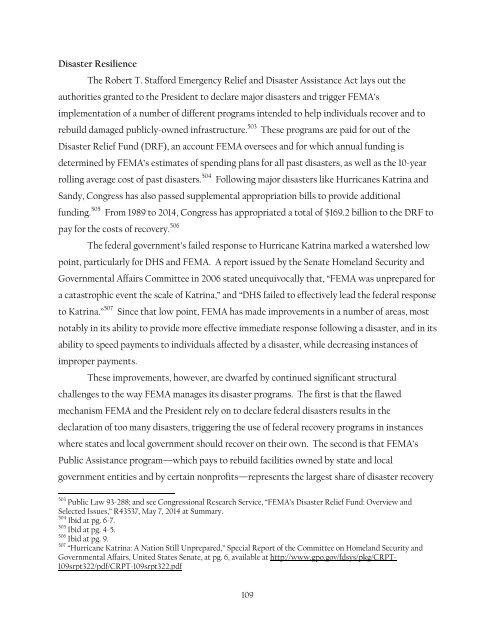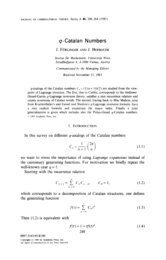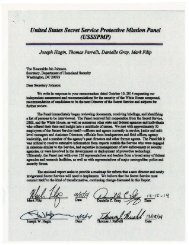010815as1
Create successful ePaper yourself
Turn your PDF publications into a flip-book with our unique Google optimized e-Paper software.
Disaster Resilience<br />
The Robert T. Stafford Emergency Relief and Disaster Assistance Act lays out the<br />
authorities granted to the President to declare major disasters and trigger FEMA’s<br />
implementation of a number of different programs intended to help individuals recover and to<br />
rebuild damaged publicly-owned infrastructure. 503 These programs are paid for out of the<br />
Disaster Relief Fund (DRF), an account FEMA oversees and for which annual funding is<br />
determined by FEMA’s estimates of spending plans for all past disasters, as well as the 10-year<br />
rolling average cost of past disasters. 504 Following major disasters like Hurricanes Katrina and<br />
Sandy, Congress has also passed supplemental appropriation bills to provide additional<br />
funding. 505 From 1989 to 2014, Congress has appropriated a total of $169.2 billion to the DRF to<br />
pay for the costs of recovery. 506<br />
The federal government’s failed response to Hurricane Katrina marked a watershed low<br />
point, particularly for DHS and FEMA. A report issued by the Senate Homeland Security and<br />
Governmental Affairs Committee in 2006 stated unequivocally that, “FEMA was unprepared for<br />
a catastrophic event the scale of Katrina,” and “DHS failed to effectively lead the federal response<br />
to Katrina.” 507 Since that low point, FEMA has made improvements in a number of areas, most<br />
notably in its ability to provide more effective immediate response following a disaster, and in its<br />
ability to speed payments to individuals affected by a disaster, while decreasing instances of<br />
improper payments.<br />
These improvements, however, are dwarfed by continued significant structural<br />
challenges to the way FEMA manages its disaster programs. The first is that the flawed<br />
mechanism FEMA and the President rely on to declare federal disasters results in the<br />
declaration of too many disasters, triggering the use of federal recovery programs in instances<br />
where states and local government should recover on their own. The second is that FEMA’s<br />
Public Assistance program—which pays to rebuild facilities owned by state and local<br />
government entities and by certain nonprofits—represents the largest share of disaster recovery<br />
503 Public Law 93-288; and see Congressional Research Service, “FEMA’s Disaster Relief Fund: Overview and<br />
Selected Issues,” R43537, May 7, 2014 at Summary.<br />
504 Ibid at pg. 6-7.<br />
505 Ibid at pg. 4-5.<br />
506 Ibid at pg. 9.<br />
507 “Hurricane Katrina: A Nation Still Unprepared,” Special Report of the Committee on Homeland Security and<br />
Governmental Affairs, United States Senate, at pg. 6, available at http://www.gpo.gov/fdsys/pkg/CRPT-<br />
109srpt322/pdf/CRPT-109srpt322.pdf<br />
109








![55721335-d6fe09eb5ffdcc87dbf6c3f0b5bbda07d2261e98[1]](https://img.yumpu.com/56533583/1/186x260/55721335-d6fe09eb5ffdcc87dbf6c3f0b5bbda07d2261e981.jpg?quality=85)








